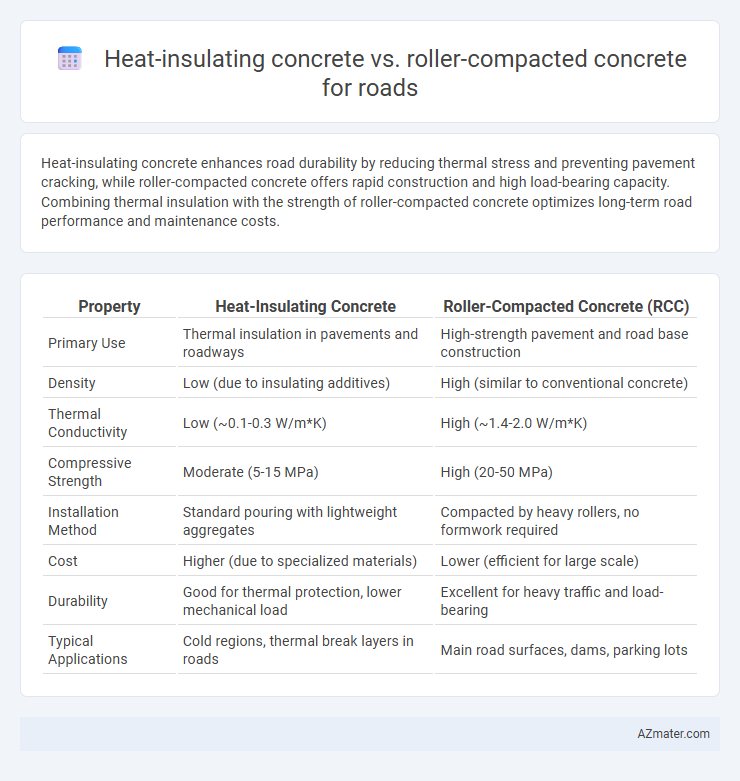Heat-insulating concrete enhances road durability by reducing thermal stress and preventing pavement cracking, while roller-compacted concrete offers rapid construction and high load-bearing capacity. Combining thermal insulation with the strength of roller-compacted concrete optimizes long-term road performance and maintenance costs.
Table of Comparison
| Property | Heat-Insulating Concrete | Roller-Compacted Concrete (RCC) |
|---|---|---|
| Primary Use | Thermal insulation in pavements and roadways | High-strength pavement and road base construction |
| Density | Low (due to insulating additives) | High (similar to conventional concrete) |
| Thermal Conductivity | Low (~0.1-0.3 W/m*K) | High (~1.4-2.0 W/m*K) |
| Compressive Strength | Moderate (5-15 MPa) | High (20-50 MPa) |
| Installation Method | Standard pouring with lightweight aggregates | Compacted by heavy rollers, no formwork required |
| Cost | Higher (due to specialized materials) | Lower (efficient for large scale) |
| Durability | Good for thermal protection, lower mechanical load | Excellent for heavy traffic and load-bearing |
| Typical Applications | Cold regions, thermal break layers in roads | Main road surfaces, dams, parking lots |
Introduction to Heat-Insulating Concrete and Roller-Compacted Concrete
Heat-insulating concrete enhances thermal performance by incorporating materials such as expanded perlite or polystyrene beads to reduce heat transfer, making it ideal for road surfaces exposed to extreme temperature variations. Roller-compacted concrete (RCC) uses a drier mix that is compacted with rollers, offering high strength and rapid curing suitable for heavy-traffic pavements. Both materials provide unique benefits: heat-insulating concrete improves energy efficiency and longevity by reducing thermal cracking, while RCC ensures structural durability and faster construction cycles.
Core Composition and Material Differences
Heat-insulating concrete incorporates lightweight aggregates such as expanded polystyrene beads or perlite to enhance thermal resistance, resulting in low thermal conductivity and improved energy efficiency. Roller-compacted concrete consists mainly of a drier mix with a higher proportion of coarse aggregates and less water content, optimized for rapid compaction and high load-bearing capacity. The core composition differences impact their performance, with heat-insulating concrete prioritizing thermal insulation while roller-compacted concrete emphasizes structural strength and durability for heavy traffic roads.
Thermal Performance in Road Applications
Heat-insulating concrete enhances road durability by significantly reducing heat transfer, thereby minimizing thermal cracking and surface deterioration under extreme temperature fluctuations. Roller-compacted concrete offers high strength and rapid construction benefits but lacks the superior thermal insulation properties critical for maintaining stable pavement temperatures. Optimizing thermal performance in road applications requires balancing the insulating capacity of heat-insulating concrete with the structural advantages of roller-compacted concrete to extend pavement lifespan and improve ride quality.
Structural Strength and Load-Bearing Capacity
Heat-insulating concrete offers superior thermal resistance, reducing temperature-induced stress and enhancing the durability of road surfaces under variable climatic conditions, but it generally exhibits lower compressive strength compared to roller-compacted concrete (RCC). Roller-compacted concrete, known for its high density and compaction, delivers exceptional structural strength and load-bearing capacity, making it ideal for heavy traffic roads and industrial pavements. While RCC supports higher traffic loads with minimal deformation, heat-insulating concrete is better suited for applications prioritizing thermal management and freeze-thaw cycle resistance in road infrastructure.
Installation Techniques and Equipment Requirements
Heat-insulating concrete for roads requires specialized installation techniques such as the incorporation of insulating additives and careful layering to enhance thermal resistance, typically demanding standard concrete mixers and precise temperature control equipment. Roller-compacted concrete (RCC) installation involves spreading with standard asphalt pavers followed by compaction using heavy vibratory rollers, emphasizing rapid setting and high density without forms or finishing. Equipment for RCC is more specialized in heavy compaction and paving machinery, while heat-insulating concrete installation prioritizes thermal management tools and precision mixing systems.
Durability and Longevity on Road Surfaces
Heat-insulating concrete enhances road surface durability by reducing thermal cracks caused by temperature fluctuations, effectively extending pavement service life in extreme climates. Roller-compacted concrete (RCC) offers superior compressive strength and resistance to heavy traffic loads, ensuring longevity through high-density compaction and rapid curing. Combining thermal insulation properties with RCC can optimize road longevity by mitigating both mechanical stress and thermal degradation.
Environmental Impact and Sustainability Factors
Heat-insulating concrete reduces energy consumption by maintaining road surface temperature and minimizing heat island effects, thereby lowering overall environmental impact. Roller-compacted concrete (RCC) emphasizes rapid construction and resource efficiency, reducing carbon emissions through lower cement content and less curing water. Both materials enhance road sustainability, with heat-insulating concrete contributing to climate resilience and RCC promoting reduced life-cycle environmental footprints.
Cost Comparison: Initial and Lifecycle Expenses
Heat-insulating concrete typically incurs higher initial costs due to specialized materials and production techniques, whereas roller-compacted concrete (RCC) offers lower upfront expenses due to simpler mixing and placement processes. Lifecycle costs for heat-insulating concrete can be reduced by improved thermal performance, leading to lower maintenance and energy-related repairs in certain climates. RCC's durability and fast construction reduce long-term repair costs and traffic disruption expenses, balancing its lifecycle cost advantage despite potentially higher maintenance in harsh conditions.
Maintenance Demands and Repair Considerations
Heat-insulating concrete offers superior thermal regulation, reducing pavement surface temperature fluctuations and consequently lowering maintenance frequency related to thermal cracking. Roller-compacted concrete demonstrates exceptional structural strength and durability, yet may require more frequent resurfacing due to its rougher texture and susceptibility to surface wear under heavy traffic. Repair considerations for heat-insulating concrete demand specialized materials to maintain thermal properties, whereas roller-compacted concrete repairs emphasize restoring load-bearing capacity and surface smoothness.
Best Use Cases and Suitability for Different Road Types
Heat-insulating concrete excels in applications requiring enhanced thermal regulation, making it ideal for roads in climates with extreme temperature variations to prevent pavement cracking and extend lifespan. Roller-compacted concrete (RCC) is highly suitable for heavy-traffic roads such as highways and industrial areas due to its high strength, rapid construction, and cost-effectiveness. While heat-insulating concrete is best for urban or residential streets requiring temperature control, RCC is preferred for highways, airport pavements, and other high-load infrastructure needing durability and quick installation.

Infographic: Heat-insulating concrete vs Roller-compacted concrete for Road
 azmater.com
azmater.com